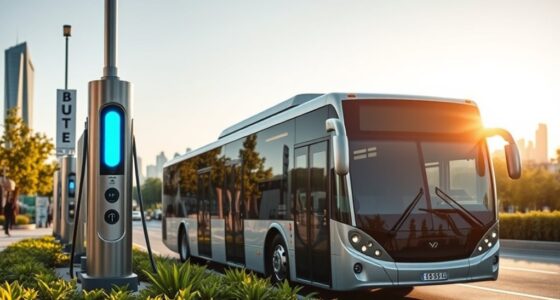To store electric buses during off-seasons, keep them indoors or under protective canopies with controlled temperatures between 55°F and 60°F and proper humidity to prevent corrosion. Maintain batteries at around 50% charge, monitor their health regularly, and perform preconditioning before reuse. Use thermal insulation and manage charging during off-peak hours to save costs. Ensuring infrastructure is weather-ready and tracking conditions helps maximize lifespan. Explore these techniques further to safeguard your buses effectively.
Key Takeaways
- Store buses indoors or under protective canopies to shield from weather elements and temperature fluctuations.
- Maintain batteries at 50% charge and optimal temperatures (15–35°C) to prevent performance degradation during storage.
- Regularly inspect and calibrate battery management systems, monitors, and physical components for early detection of issues.
- Implement thermal insulation and heating systems to prevent condensation, freezing, and thermal stress in cold climates.
- Schedule periodic preconditioning and charge/discharge cycles to preserve battery health and readiness for reuse.
Optimizing Indoor Storage Conditions for Electric Buses

Optimizing indoor storage conditions for electric buses is essential to guarantee their longevity and reliable performance. You should maintain a stable temperature between 55°F and 60°F to prevent thermal stress on batteries and electrical components. Wall organization systems can also be employed within indoor spaces to optimize layout and safety. Controlling humidity levels is equally important; excessive moisture can cause corrosion and damage sensitive systems. Proper ventilation is crucial to avoid the buildup of harmful fumes and maintain air quality. Installing fire suppression systems protects your investment from potential hazards. Additionally, provide indoor charging points to shield equipment from outdoor weather, reducing exposure to rain and temperature fluctuations. Selecting storage locations in climate-friendly areas with mild winters minimizes heating needs. Using natural sunlight for warming during the day and installing protective awnings can further shield buses from harsh weather, helping preserve their condition during downtime. Implementing climate control measures can further enhance storage conditions, preventing temperature fluctuations that may harm electrical systems. Incorporating monitoring systems can also help detect and address environmental fluctuations promptly, ensuring optimal storage environments. Incorporating regular maintenance routines will also help identify early signs of environmental damage and extend the lifespan of the buses.
Effective Battery Management During Extended Storage
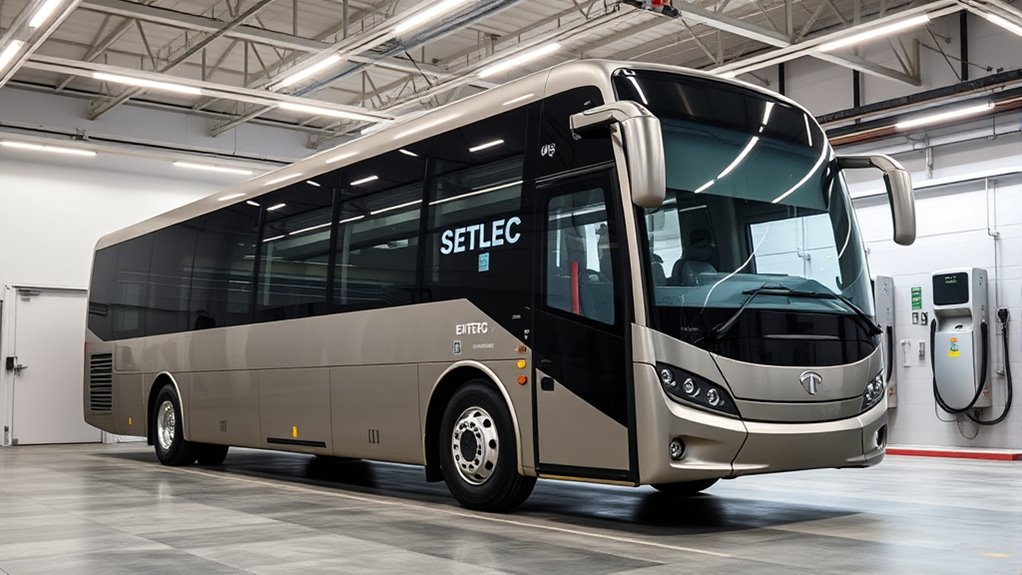
Maintaining the health of electric bus batteries during extended storage requires careful management of several key factors. First, control the temperature by keeping batteries between 15–35°C (59–95°F) to prevent performance decline. Regularly monitor the State of Health (SOH) to identify capacity loss early and schedule maintenance accordingly. Store batteries at around 50% charge to avoid overcharging or deep discharges that can harm cells. Limit deep discharge cycles and avoid high voltages to reduce stress and degradation. Use advanced battery management systems for real-time monitoring and predictive analytics, enabling proactive interventions. Periodically check and balance the batteries to ensure even charge distribution. Implementing proper Kia Tuning techniques can also help optimize battery performance and longevity during storage. Proper battery conditioning practices, including periodic charge and discharge cycles, can further enhance battery stability and extend lifespan during off-seasons. Additionally, maintaining optimal storage conditions helps prevent battery deterioration caused by environmental factors. Staying informed about manufacturer warranty policies is essential to avoid potential issues if reconditioning or maintenance is needed during storage. Ultimately, keep detailed records of storage conditions and battery health to optimize practices and extend battery lifespan during off-seasons.
Thermal Insulation Techniques to Preserve Battery Health
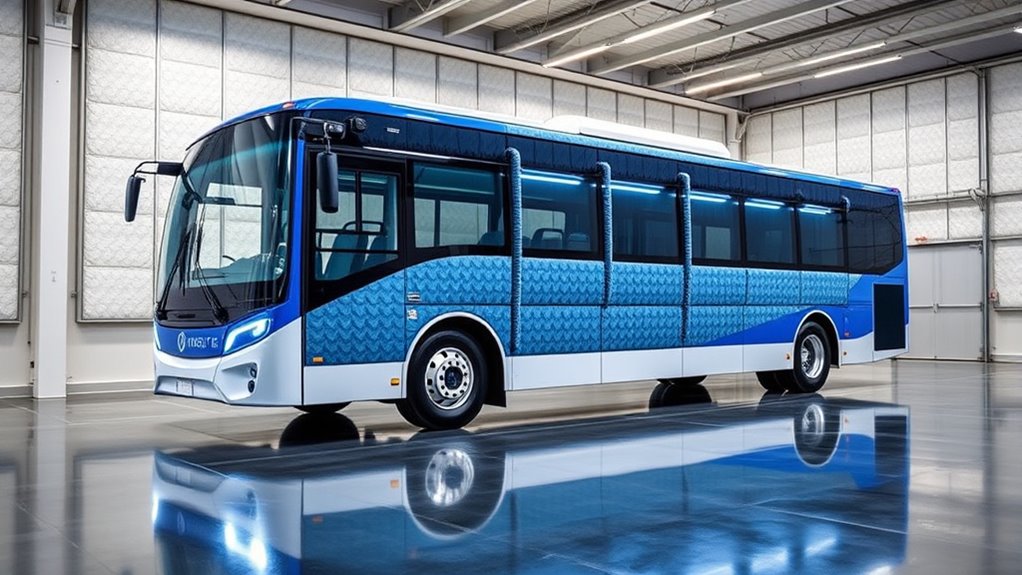
Effective thermal insulation is essential for preserving electric bus battery health during storage, as it minimizes temperature fluctuations that can accelerate degradation. Using advanced materials like silicone binders with hollow glass beads in syntactic foam reduces water absorption and maintains consistent temperatures. HEPA filtration can also be incorporated into ventilation systems to ensure air quality during long-term storage, preventing mold and moisture buildup. Polyimide foams offer stability from -196°C to +300°C, providing effective thermal and acoustic insulation. High-resistance Nomex and polyester films protect busbars and motor windings from heat transfer. Thermal gap fillers ensure uniform heat dissipation during inactive periods. Modular insulation systems at the cell and module levels prevent thermal runaway spread. Centralized heat sink boxes with phase-change materials enable passive cooling. Incorporating coolant channels and thermal spacers further enhances heat management, safeguarding battery health during storage. Additionally, understanding thermal properties of insulation materials helps optimize their performance in maintaining consistent temperatures. Proper insulation can also help in preventing condensation, which is crucial for avoiding moisture-related issues. To enhance insulation effectiveness, selecting materials with optimal thermal conductivity is crucial for long-term storage stability.
Strategic Charging Practices to Minimize Energy Costs
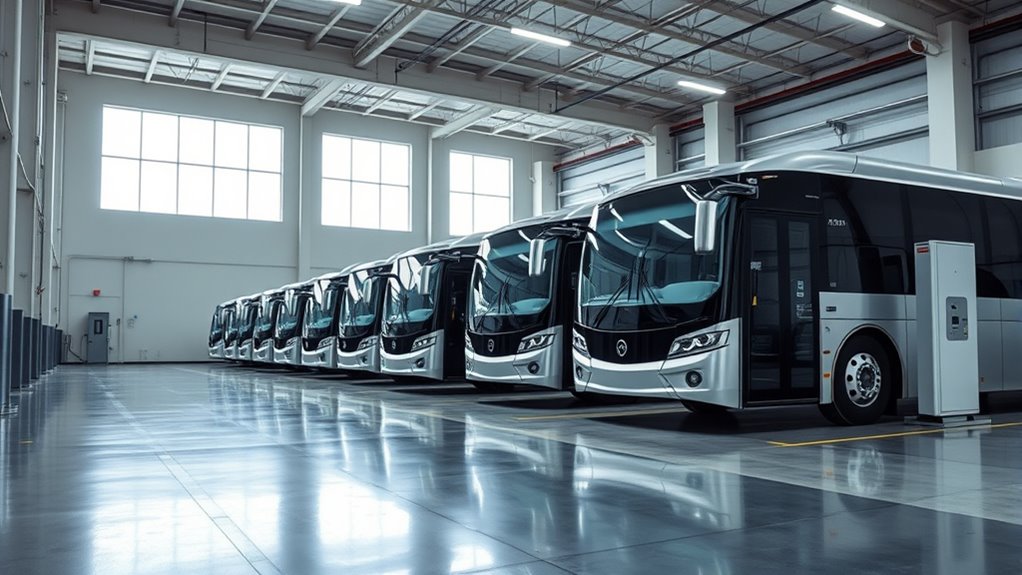
Strategic charging practices can substantially reduce energy costs for electric bus fleets by aligning charging schedules with utility rate structures. You should leverage off-peak hours, typically overnight, when electricity demand and rates are lowest. Monitoring time-of-use (TOU) rates helps you optimize charging times and avoid peak-demand charges. Incorporating sound design principles into your operational communications can improve clarity and engagement with staff responsible for managing charging schedules. Using 50–150 kW DC slow chargers overnight balances cost-efficiency with battery health. Implement managed charging software to automate schedules based on grid loads and utility rates. To prevent demand spikes, avoid simultaneous high-power charging across multiple buses. Deploy scalable, modular charging infrastructure that can adapt to seasonal needs. Incorporating battery preservation strategies, such as appropriate charging practices and storage conditions, helps preserve battery capacity over time. Regular load management audits can ensure your depot maintains cost-effective, reliable charging while minimizing energy expenses during storage periods. Additionally, implementing coordinated charging strategies can further optimize energy use and reduce operational costs. Incorporating renewable energy sources, like solar, to offset grid dependency.
Maintaining Charging Infrastructure Readiness in Cold Weather
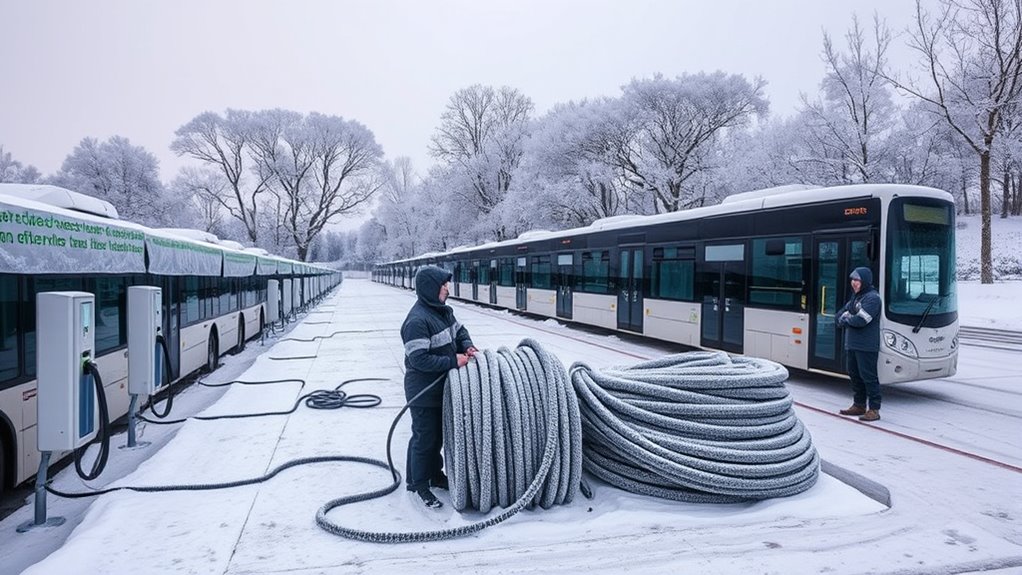
Cold weather poses significant challenges to keeping your electric bus charging infrastructure ready for daily operations. To prevent snow and ice buildup, store chargers in enclosed spaces or install outdoor canopies that shield them from precipitation. Use heated charging cabinets or insulation to maintain ideal temperatures and guarantee cable flexibility. Choose cold-rated hardware designed for sub-zero conditions to avoid failures.
Elevate stations to prevent pooling water or ice around electrical components. Regularly check and activate heating systems to keep chargers and cables warm, and ensure connections remain clear of ice. Stock de-icing supplies and install anti-freeze dispensers near charging stations to prevent ice formation. Additionally, inspecting headphone connectors and ensuring proper maintenance can help prevent issues caused by moisture and cold conditions, as well as corrosion on electrical parts, ensuring reliable operation of your equipment. Implement remote monitoring to detect malfunctions early, which can help identify issues caused by electrical component failures before they disrupt operations, maintaining reliable charging readiness throughout the cold months.
Routine Inspection and Preventative Maintenance Protocols
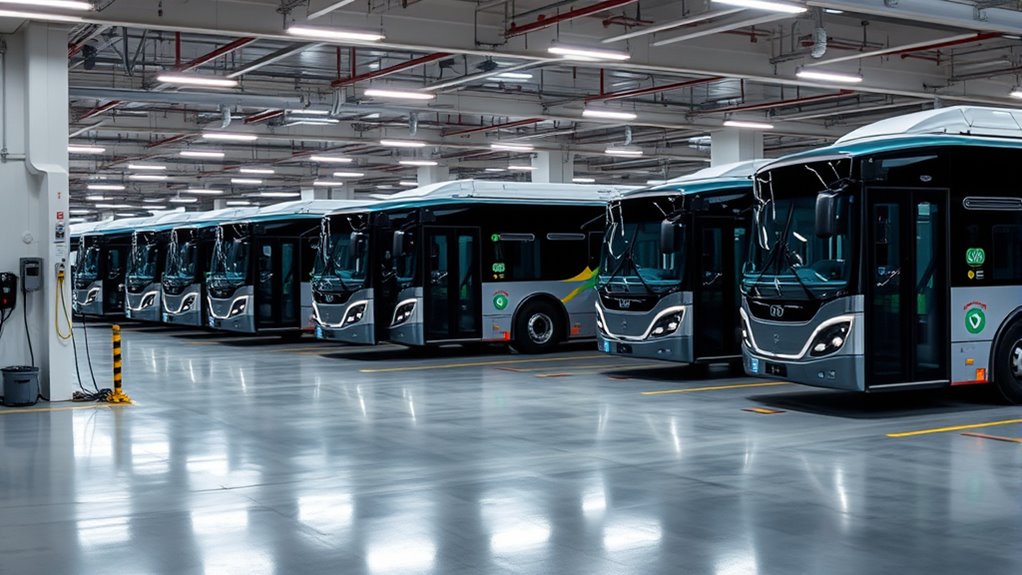
Routine inspection and preventative maintenance are essential to guarantee your electric bus storage and charging systems remain reliable over time. You should verify battery health metrics like state of charge, voltage, and thermal management to detect early issues. A focus on system efficiency and proper operation of components can help prevent costly repairs and extend the lifespan of your equipment. Inspect battery casings and connections for cracks, leaks, or corrosion, and calibrate the battery management system to ensure accurate monitoring. Regularly check climate control systems, ensuring indoor temperatures stay between 40–86°F and humidity remains controlled. Disconnect high-voltage components, apply dielectric grease, and inspect wiring for damage or corrosion. Incorporating cold-pressed vegetable juice in maintenance routines can help support overall system health by providing antioxidants that protect electronic components. Proper battery management is crucial for optimal performance and longevity of your electric bus batteries. Implementing hydrocolloid technology can also aid in monitoring moisture levels and preventing moisture-related damage. These steps help prevent failures and extend your electric bus’s lifespan during off-seasons.
Training Staff on Proper Storage and Handling Procedures

Properly training staff on storage and handling procedures is critical to ensuring safety and compliance when managing electric bus batteries. You need to provide OSHA and manufacturer-specific training that covers battery safety protocols, spill containment during electrolyte leaks, and UN/DOT 38.3 compliance for lithium-ion transport.
Staff must also practice thermal runaway response drills using NFPA-recommended methods and pass competency assessments on disconnecting and reconnecting batteries safely. Ensuring everyone understands the importance of climate-controlled environments, proper SOC management, and emergency response procedures minimizes risks.
Regular training keeps staff updated on regulations like ECE R100, SAE J2464, and NFPA standards. Properly trained personnel prevent accidents, safeguard assets, and maintain compliance during storage, handling, and emergency situations.
Utilizing Preconditioning to Prepare Buses for Reuse

Preconditioning is essential for preparing electric buses for reuse, ensuring their batteries and cabin systems operate efficiently and safely.
You should maintain battery temperatures between 20°C and 40°C during storage to preserve battery health. Precondition the batteries before reuse by using grid power while plugged in, preventing depletion of onboard reserves.
Schedule mid-day or end-of-day charging during off-peak hours to reduce strain and costs. Monitor thermal management systems to prevent temperature fluctuations.
For cabin comfort, preheat the interior while charging and seal the cabin thoroughly to retain heat. Automate climate control with timers and upgrade insulation to maintain stable temperatures.
Protecting Buses From Environmental Elements During Off-Seasons

During off-seasons, protecting electric buses from environmental elements is crucial to maintain their performance and longevity. Store buses indoors or under protective canopies to minimize temperature fluctuations and reduce strain on thermal management systems.
Covered parking prevents snow, ice, and road salt from accumulating on buses and charging equipment. Climate-controlled environments help keep batteries within the ideal 40–86°F range. Outdoor shelters with sunlight exposure can also help stabilize battery temperatures.
Optimize parking orientation to maximize sunlight during daylight hours and ensure clear access around chargers. Seal gaps with weather stripping, add insulation, and use anti-corrosion coatings to shield electrical components and metal parts from moisture, rain, and snow.
These measures greatly extend bus lifespan and preserve operational efficiency during off-seasons.
Monitoring and Documenting Storage Conditions for Warranty Compliance

Effective storage of electric buses relies heavily on meticulous monitoring and documentation of environmental conditions to guarantee warranty compliance. You should clearly define warranty language, especially for battery systems, to prevent misunderstandings.
Use advanced data logging systems like ZF Bus Connect to track vehicle health in real time, ensuring storage conditions meet industry standards such as ECE R100 Revision 2 and SAE J2464. Continuous remote monitoring allows you to detect issues early and schedule preventive maintenance, reducing potential damage.
Maintain detailed records of storage conditions, environmental factors, and system performance through customizable reports. Secure data storage is essential for compliance and warranty validation.
Consistent documentation not only helps meet warranty requirements but also provides valuable insights for optimizing storage practices and prolonging vehicle lifespan.
Frequently Asked Questions
How Often Should Battery SOC Be Checked During Long-Term Storage?
You should verify the battery SOC during long-term storage at least once every 30 days, especially if temperature fluctuations exceed ±10°C. Regular monitoring helps catch any drift or self-discharge issues early.
Also, perform an immediate check after extreme weather events.
Align your SOC checks with cell-balancing intervals every 60-90 days, and verify SOC 48 hours before reactivating the bus to ensure safe and reliable operation.
What Are Signs of Battery Degradation After Extended Off-Season Storage?
Think of your battery as a delicate garden that needs regular care. After extended off-season storage, watch for signs like reduced capacity—your bus won’t go as far—and longer charging times, which signal internal issues.
Varying voltage readings and increased temperature sensitivity also point to degradation. If you notice these signs, it’s time to give your battery some extra attention before putting it back into service.
How Can Thermal Management Systems Be Optimized for Seasonal Storage?
You can optimize thermal management systems for seasonal storage by using independent Battery Thermal Management Systems (BTMS) to maintain ideal battery temperatures, especially in cold weather.
Store buses indoors or in sunny areas, add insulation, and precondition batteries before use.
Regularly inspect and monitor systems to guarantee proper functioning, reducing energy use and extending battery life.
Proper thermal control keeps your electric buses ready and efficient during off-seasons.
What Are Best Practices for Reactivating Buses After Long Storage Periods?
When reactivating buses after long storage, you should start with thorough safety inspections and verify all electrical and mechanical systems.
Check tire conditions and update software as needed.
Follow manufacturer guidelines for reactivation, perform functional tests, and monitor performance metrics.
Gradually deploy the buses to ensure they operate smoothly, and provide driver training on new features.
Schedule routine maintenance to keep everything running at its best and document all reactivation activities.
How to Troubleshoot Charging Station Issues in Cold Weather Conditions?
You might think cold weather makes charging stations unreliable, but with proper troubleshooting, you can keep them running smoothly.
Start by protecting stations from snow and ice, and perform regular inspections to spot issues early.
Check circuits and power supplies to guarantee stability, and consider installing backup systems for outages.
Conclusion
As you prep your electric buses for off-season storage, imagine them nestled in a cozy, climate-controlled garage, their batteries humming softly, protected from harsh weather. With proper insulation, strategic charging, and attentive monitoring, you create a safe haven that keeps your fleet ready to roll when spring arrives. Think of it as giving your buses a peaceful rest, ensuring they wake up refreshed, healthy, and enthusiastic to hit the road once again.


